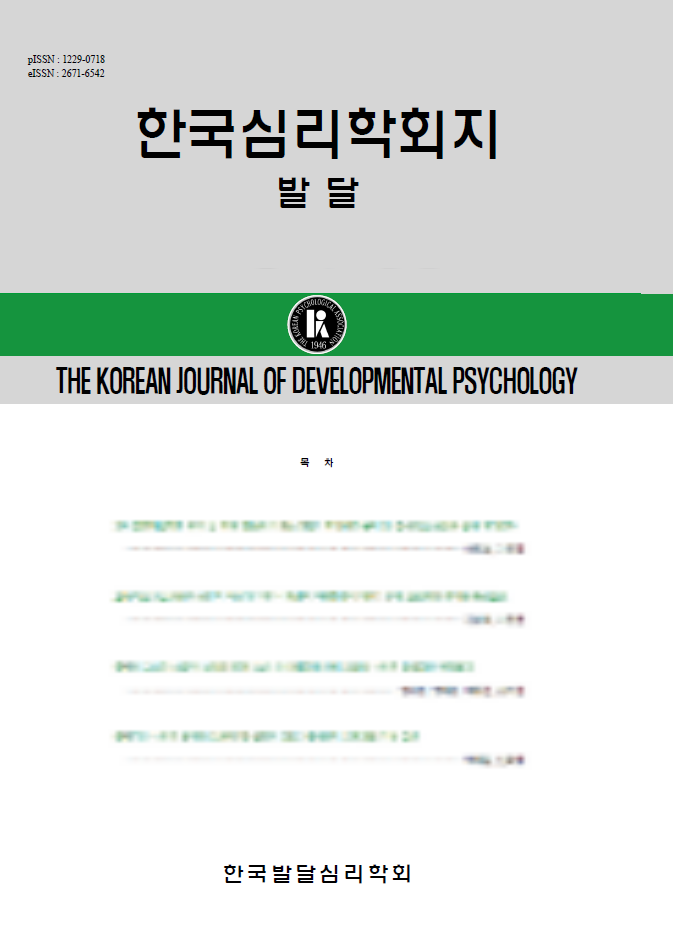open access
메뉴
open access
메뉴 ISSN : 1229-0718
ISSN : 1229-0718

본 연구는 문제 해결을 위한 상호작용 상황에서, 어머니 행동특성을 이루는 변인들과 유아의 행동특성을 이루는 변인들 간의 관계와 영향력, 그리고 어머니 행동특성이 애착안정성과 유아의 행동특성을 매개하는지와 이들 변인들의 상대적 영향력은 어떠한지에 대하여 알아보았다. 이를 위해 33명의 30~42개월 유아들과 이들 어머니 쌍을 대상으로 Erickson, Sroufe와 Egeland(1985)가 고안하고 정지나(1997)가 번안한 4가지 과제, Q-set 개정판을 통하여 어머니 행동특성과 아동행동특성, 애착 안정성을 각각 측정하였다. 연구 결과, 어머니 행동특성을 이루는 변인들과 유아 행동특성을 이루는 변인들 간에는 대체적으로 유의미한 정적 상관을 보였다. 이를 기초로 정준 상관 분석을 실시, 어머니의 유아에 대한 믿음, 긍정적인 정서지지가 유아의 인내력과 문제를 통한 긍정적 경험, 긍정적 정서와 정적인 관계구조를 가지는 것을 알 수 있었다. 또한 애착안정성은 어머니 행동특성과 함께 했을 때만 유아행동특성을 유의미하게 설명하여 어머니 행동특성의 완전 매개역할을 검증하였다. 이러한 결과를 토대로 유아 행동특성들에 대한 어머니 행동특성변인들과 애착안정성의 상대적 영향력의 단계적 회귀분석 검증에서, 과제 상황을 잘 인내, 순응하며 회피의 경향을 적게 보이며 과제를 통해 긍정적인 경험을 하는 유아들의 행동특성은 어머니의 행동 특성 중 유아에 대한 믿음으로 가장 잘 설명될 수 있었다. 또한 과제에 대한 열정이 높고 덜 의존적이며, 상호작용 중에 긍정적인 정서를 많이 나타내는 유아의 행동특성은 어머니의 정서적 지지 행동특성 변인이, 과제 상황에서 긍정적인 경험의 유아의 행동특성은 어머니의 자율성 행동특성 변인이 가장 잘 설명해 주고 있었다.
This study investigated the effect of mother behavior characteristics and attachment security on infant behavior characteristics. The subjects were 33 infants(aged 30-42 months)and their mothers. Attachment was assessed by using the Attachment Q-set (Waters, 1987). Mother behavior characteristics and infant behavior characteristics were measured through mother-infant interactions using four problem solving tasks that required the mothers and their infants to work together. Mother-infant interactions during problem solving situation were observed with the use of the Teaching Strategies Rating Scale (Erickson, Sroufe, Egeland, 1985). The results of this study showed a significantly positive correlation between mother behavior characteristics and infant behavior characteristics. With Canonical Correlation Analysis, as the mother showed stronger confidence and positively emotional support, infants tended to report higher persistence, more positive experience and affection. Only when attachment security combine with mother behavior characteristics, it has weighty influence on infant behavior characteristics. In other words, the mediating effect of mother behavior characteristics in relationship between attachment security and infant behavior characteristics was found in mother-infant interactions. In Step-Wise Analysis, the mother's confidence to her infant has significant influence on infant's higher persistence, compliance and lower avoidance. Moreover, the mother' emotional support has an effect on infant's higher enthusiasm, affection and lower reliance. Lastly, mother's respecting autonomy to her infant has influence on infant's positive experience about Problem Solving situation.
(1984) 모-자녀 애착관계가 유아의 행동발달에 미치는 영향 사회적, 인지적 능력을 중심으로,
(1999) SAS라는 통계상자,
(1999) 문제해결 과정에서의 어머니-유아 상호작용과 관련 변인 애착과 기질,
(2000) 어머니-자녀 상호작용과 유아의 인지ㆍ사고능력에 미치는 영향,
(2000) 유아의 애착 안정성과 과제 수행시 어머니-유아 간 상호작용의 관계,
(1998) 청소년기 애착안정성과 우울성향의 관계 지각된 유능감의 매개효과를 중심으로,
(1997) 애착 Q-set의 국내 준거 개발 연구,
(1997) 어머니-유아간 상호작용과 유아의 장독립성 인지양식 간의 관계,
(1986) The moderator- mediator Variable distinction in social psychological research Journal of Personality and Social Psychology,
(1982) The organization of action and the nature of adult-infant transaction, Cambridge University Press
(1994) Emotional communication between mothers and preschoolers Relations with emotional competence,
(1985) The relationship of quality of attachment and behavior problems in preschool in a high risk sample,
(1990) Antecedents in attachment,
(1997) Mutually responsive orientation mothers and their young children: implications for Early socialization. ,
(1995) Mother-child communication sequences: Play activity, child gender, and marital status effects. ,
(1992) The role of parents in the socialization of children,
(1978) Continuity of adaptation in the second year The relationship between quality of attachment and later competence Child Development,
(1997) Attachment and joint problem-solving experiences during the preschool period,
(1993) Attachment and the development of metacognitive and collaborative strategies International Journal of Educational Research,
(1987) Family interaction in infancy Handbook of infant development, Inc
(1989) Continuity and discontinuity in intellectual test performance in high risk children, University of Virginia
(1991) observing mother and child behavior in Problem-Solving Situation at school entry Relations with classroom achievement,
(1993) Emotional communication in mother-toddler relationship Evidence for early gender differen- tiation,
(1989) Parent-infant social play in brief encounters,
(1990) Apprenticeship in thinking, Oxford University Press
(1987) Quality of attachment and early symbolic play,
(1983) Attachment and dependency on developmental perspective,
(1986) Attachment and the construction of relationships, Cambridge University Press
(1999) Handbook of attachment,
(1991) Attachment to mother and behavior with adults in preschool,
(1987) State University of New York at Stony Brook, Unpublished manual
(1990) Coordination of maternal directives with preschooler's behavior in compliance-problem and healthy dyads,
(1985) Vygotsky and the social formation of mind, Harvard University Press
(1976) The role of tutoring in problem solving Journal of child psychology and psychiatry,
